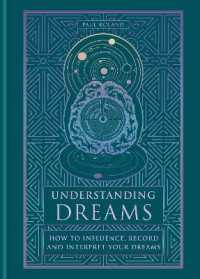- ホーム
- > 洋書
- > 英文書
- > Computer / General
Full Description
This book presents computational interaction as an approach to explaining and enhancing the interaction between humans and information technology. Computational interaction applies abstraction, automation, and analysis to inform our understanding of the structure of interaction and also to inform the design of the software that drives new and exciting human-computer interfaces. The methods of computational interaction allow, for example, designers to identify user interfaces that are optimal against some objective criteria. They also allow software engineers to build interactive systems that adapt their behaviour to better suit individual capacities and preferences.
Embedded in an iterative design process, computational interaction has the potential to complement human strengths and provide methods for generating inspiring and elegant designs.
Computational interaction does not exclude the messy and complicated behaviour of humans, rather it embraces it by, for example, using models that are sensitive to uncertainty and that capture subtle variations between individual users. It also promotes the idea that there are many aspects of interaction that can be augmented by algorithms.
This book introduces computational interaction design to the reader by exploring a wide range of computational interaction techniques, strategies and methods. It explains how techniques such as optimisation, economic modelling, machine learning, control theory, formal methods, cognitive models and statistical language processing can be used to model interaction and design more expressive, efficient and versatile interaction.
Contents
Input and interaction techniques
1: Roderick Murray-Smith: Control Theory, Dynamics and Continuous Interaction
2: Per Ola Kristensson: Statistical Language Processing for Text Entry
3: Otmar Hilliges: Input Recognition
Design
4: Antti Oulasvirta, Andreas Karrenbauer: Combinatorial Optimization for UI Design
5: Xiaojun Bi, Brian Smith, Tom Ouyang, Shumin Zhai: Soft Keyboard Performance Optimization
6: Yuki Koyama, Takeo Igarashi: Computational Design with Crowds
Systems
7: Alan Dix: Practical Formal Methods in HCI
8: Paul Cairns, Harold Thimbleby: From Premature Semantics to Mature Interaction Programming
9: Célia Martinie, Philippe Palanque, Camille Fayollas: Performance Evaluation of Interactive Systems with ICO Models
Human Behaviour
10: Andrew Howes, Xiuli Chen, Aditya Acharya, Richard L. Lewis: Interaction as an Emergent Property of a Partially Observable Markov Decision Process
11: Leif Azzopardi, Guido Zuccon: Economic Models of Interaction
12: Duncan P. Brumby, Christian P. Janssen, Tuomo Kujala, Dario D. Salvucci: Computational Models of User Multitasking
13: Wai-Tat Fu, Jessie Chin, Q. Vera Liao: The Central Role of Cognitive Computations in Human-Information Interaction
14: Nikola Banovic, Jennifer Mankoff, Anind K. Dey: Computational Model of Human Routine Behaviors
15: Wai-Tat Fu, Mingkun Gao, Hyo Jin Do: Computational Methods for Socio-Computer Interaction







